School of Computing and Maths: Ethics in IT Assignment 1 Analysis
VerifiedAdded on 2020/03/04
|6
|1982
|115
Homework Assignment
AI Summary
This assignment analyzes an ethical dilemma faced by an IT personnel regarding the deployment of an untested system. The scenario involves a supervisor mandating the delivery of a system by a tight deadline, despite the unavailability of the system tester due to illness. The analysis uses the 'Doing Ethics Technique' to identify the facts, ethical and non-ethical issues, affected stakeholders (IT personnel, supervisor, CEO, and system users), and the implications of the ethical issues, such as misleading leadership and the conflict between career and the common good. The assignment explores potential solutions, including the IT personnel standing his ground, developing amicable solutions with clients, and the company contacting the clients to develop an alternative plan, ultimately recommending an alternative solution that prioritizes system testing and maintaining client trust. The solution also includes references to the Australian Computer Society (ACS) Code of Professional Conduct and other relevant literature.
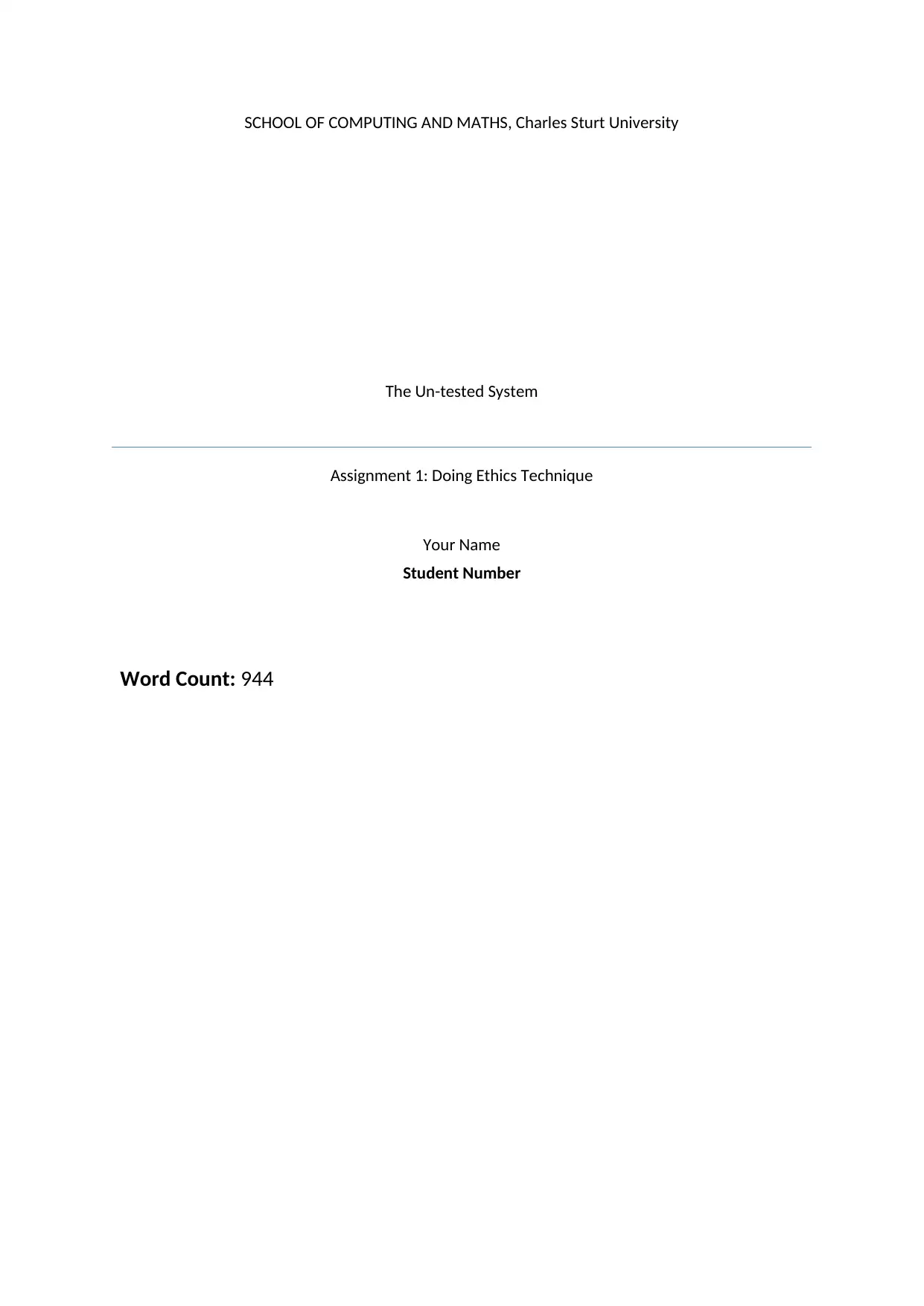
SCHOOL OF COMPUTING AND MATHS, Charles Sturt University
The Un-tested System
Assignment 1: Doing Ethics Technique
Your Name
Student Number
Word Count: 944
The Un-tested System
Assignment 1: Doing Ethics Technique
Your Name
Student Number
Word Count: 944
Paraphrase This Document
Need a fresh take? Get an instant paraphrase of this document with our AI Paraphraser
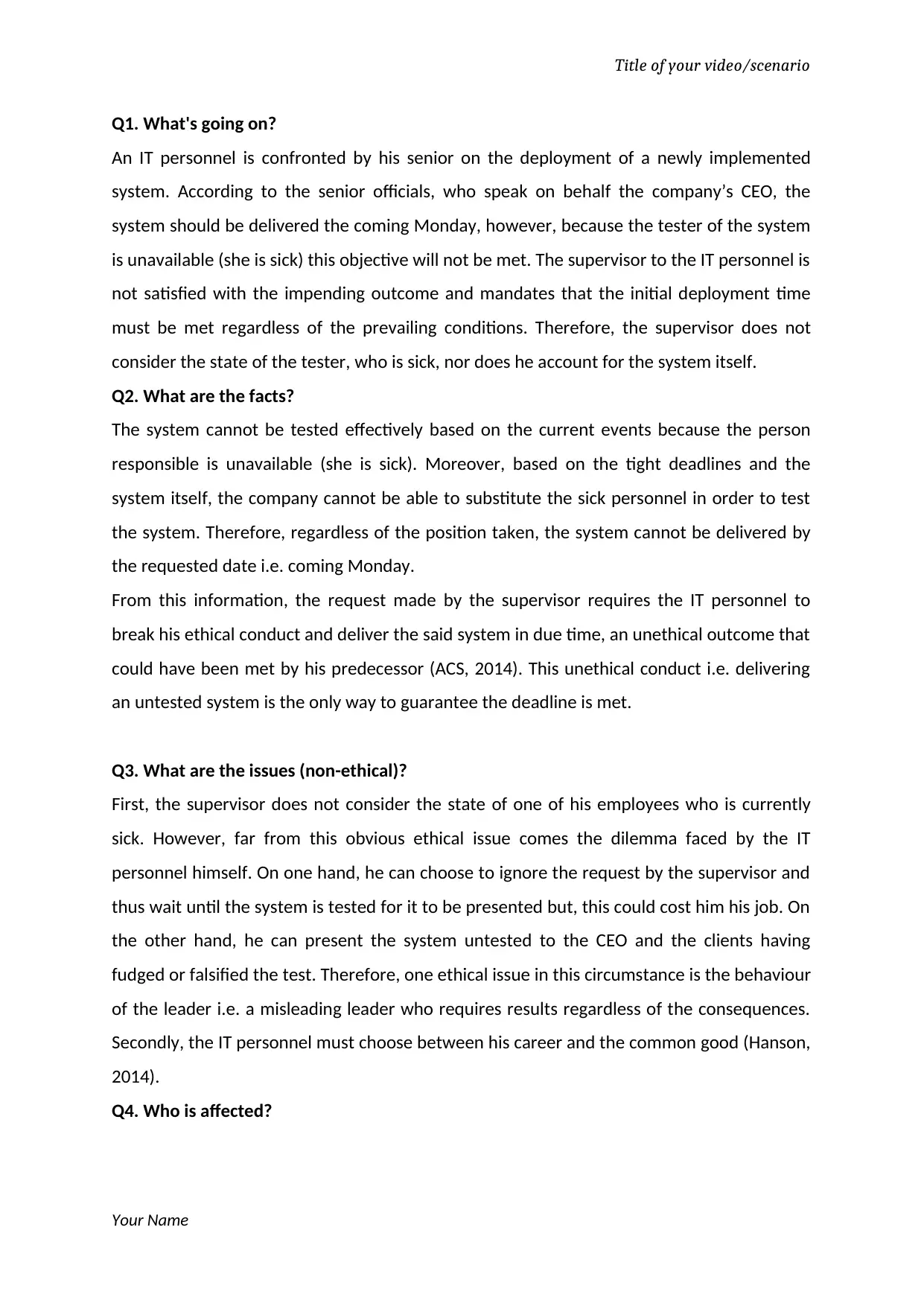
Title of your video/scenario
Q1. What's going on?
An IT personnel is confronted by his senior on the deployment of a newly implemented
system. According to the senior officials, who speak on behalf the company’s CEO, the
system should be delivered the coming Monday, however, because the tester of the system
is unavailable (she is sick) this objective will not be met. The supervisor to the IT personnel is
not satisfied with the impending outcome and mandates that the initial deployment time
must be met regardless of the prevailing conditions. Therefore, the supervisor does not
consider the state of the tester, who is sick, nor does he account for the system itself.
Q2. What are the facts?
The system cannot be tested effectively based on the current events because the person
responsible is unavailable (she is sick). Moreover, based on the tight deadlines and the
system itself, the company cannot be able to substitute the sick personnel in order to test
the system. Therefore, regardless of the position taken, the system cannot be delivered by
the requested date i.e. coming Monday.
From this information, the request made by the supervisor requires the IT personnel to
break his ethical conduct and deliver the said system in due time, an unethical outcome that
could have been met by his predecessor (ACS, 2014). This unethical conduct i.e. delivering
an untested system is the only way to guarantee the deadline is met.
Q3. What are the issues (non-ethical)?
First, the supervisor does not consider the state of one of his employees who is currently
sick. However, far from this obvious ethical issue comes the dilemma faced by the IT
personnel himself. On one hand, he can choose to ignore the request by the supervisor and
thus wait until the system is tested for it to be presented but, this could cost him his job. On
the other hand, he can present the system untested to the CEO and the clients having
fudged or falsified the test. Therefore, one ethical issue in this circumstance is the behaviour
of the leader i.e. a misleading leader who requires results regardless of the consequences.
Secondly, the IT personnel must choose between his career and the common good (Hanson,
2014).
Q4. Who is affected?
Your Name
Q1. What's going on?
An IT personnel is confronted by his senior on the deployment of a newly implemented
system. According to the senior officials, who speak on behalf the company’s CEO, the
system should be delivered the coming Monday, however, because the tester of the system
is unavailable (she is sick) this objective will not be met. The supervisor to the IT personnel is
not satisfied with the impending outcome and mandates that the initial deployment time
must be met regardless of the prevailing conditions. Therefore, the supervisor does not
consider the state of the tester, who is sick, nor does he account for the system itself.
Q2. What are the facts?
The system cannot be tested effectively based on the current events because the person
responsible is unavailable (she is sick). Moreover, based on the tight deadlines and the
system itself, the company cannot be able to substitute the sick personnel in order to test
the system. Therefore, regardless of the position taken, the system cannot be delivered by
the requested date i.e. coming Monday.
From this information, the request made by the supervisor requires the IT personnel to
break his ethical conduct and deliver the said system in due time, an unethical outcome that
could have been met by his predecessor (ACS, 2014). This unethical conduct i.e. delivering
an untested system is the only way to guarantee the deadline is met.
Q3. What are the issues (non-ethical)?
First, the supervisor does not consider the state of one of his employees who is currently
sick. However, far from this obvious ethical issue comes the dilemma faced by the IT
personnel himself. On one hand, he can choose to ignore the request by the supervisor and
thus wait until the system is tested for it to be presented but, this could cost him his job. On
the other hand, he can present the system untested to the CEO and the clients having
fudged or falsified the test. Therefore, one ethical issue in this circumstance is the behaviour
of the leader i.e. a misleading leader who requires results regardless of the consequences.
Secondly, the IT personnel must choose between his career and the common good (Hanson,
2014).
Q4. Who is affected?
Your Name
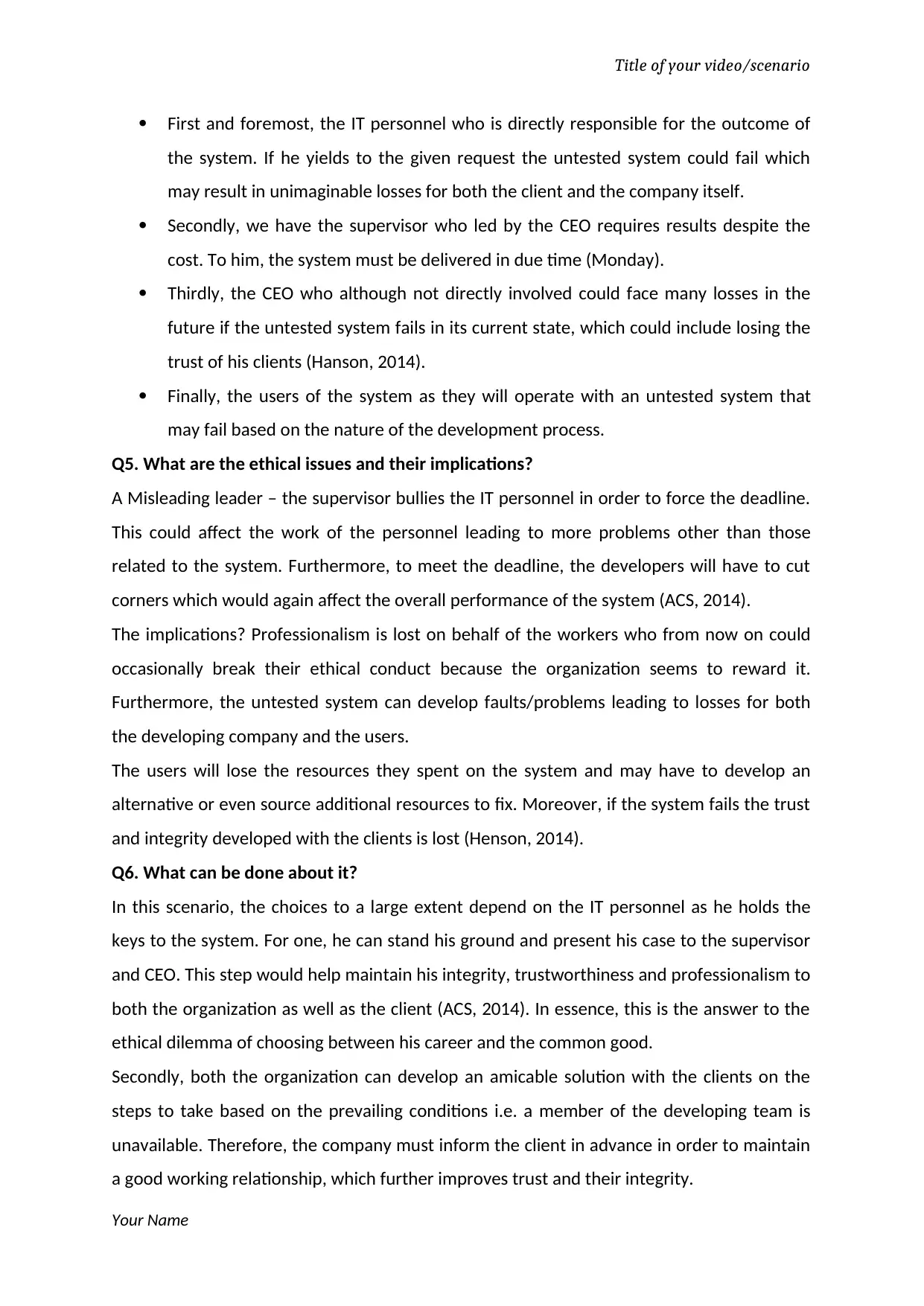
Title of your video/scenario
First and foremost, the IT personnel who is directly responsible for the outcome of
the system. If he yields to the given request the untested system could fail which
may result in unimaginable losses for both the client and the company itself.
Secondly, we have the supervisor who led by the CEO requires results despite the
cost. To him, the system must be delivered in due time (Monday).
Thirdly, the CEO who although not directly involved could face many losses in the
future if the untested system fails in its current state, which could include losing the
trust of his clients (Hanson, 2014).
Finally, the users of the system as they will operate with an untested system that
may fail based on the nature of the development process.
Q5. What are the ethical issues and their implications?
A Misleading leader – the supervisor bullies the IT personnel in order to force the deadline.
This could affect the work of the personnel leading to more problems other than those
related to the system. Furthermore, to meet the deadline, the developers will have to cut
corners which would again affect the overall performance of the system (ACS, 2014).
The implications? Professionalism is lost on behalf of the workers who from now on could
occasionally break their ethical conduct because the organization seems to reward it.
Furthermore, the untested system can develop faults/problems leading to losses for both
the developing company and the users.
The users will lose the resources they spent on the system and may have to develop an
alternative or even source additional resources to fix. Moreover, if the system fails the trust
and integrity developed with the clients is lost (Henson, 2014).
Q6. What can be done about it?
In this scenario, the choices to a large extent depend on the IT personnel as he holds the
keys to the system. For one, he can stand his ground and present his case to the supervisor
and CEO. This step would help maintain his integrity, trustworthiness and professionalism to
both the organization as well as the client (ACS, 2014). In essence, this is the answer to the
ethical dilemma of choosing between his career and the common good.
Secondly, both the organization can develop an amicable solution with the clients on the
steps to take based on the prevailing conditions i.e. a member of the developing team is
unavailable. Therefore, the company must inform the client in advance in order to maintain
a good working relationship, which further improves trust and their integrity.
Your Name
First and foremost, the IT personnel who is directly responsible for the outcome of
the system. If he yields to the given request the untested system could fail which
may result in unimaginable losses for both the client and the company itself.
Secondly, we have the supervisor who led by the CEO requires results despite the
cost. To him, the system must be delivered in due time (Monday).
Thirdly, the CEO who although not directly involved could face many losses in the
future if the untested system fails in its current state, which could include losing the
trust of his clients (Hanson, 2014).
Finally, the users of the system as they will operate with an untested system that
may fail based on the nature of the development process.
Q5. What are the ethical issues and their implications?
A Misleading leader – the supervisor bullies the IT personnel in order to force the deadline.
This could affect the work of the personnel leading to more problems other than those
related to the system. Furthermore, to meet the deadline, the developers will have to cut
corners which would again affect the overall performance of the system (ACS, 2014).
The implications? Professionalism is lost on behalf of the workers who from now on could
occasionally break their ethical conduct because the organization seems to reward it.
Furthermore, the untested system can develop faults/problems leading to losses for both
the developing company and the users.
The users will lose the resources they spent on the system and may have to develop an
alternative or even source additional resources to fix. Moreover, if the system fails the trust
and integrity developed with the clients is lost (Henson, 2014).
Q6. What can be done about it?
In this scenario, the choices to a large extent depend on the IT personnel as he holds the
keys to the system. For one, he can stand his ground and present his case to the supervisor
and CEO. This step would help maintain his integrity, trustworthiness and professionalism to
both the organization as well as the client (ACS, 2014). In essence, this is the answer to the
ethical dilemma of choosing between his career and the common good.
Secondly, both the organization can develop an amicable solution with the clients on the
steps to take based on the prevailing conditions i.e. a member of the developing team is
unavailable. Therefore, the company must inform the client in advance in order to maintain
a good working relationship, which further improves trust and their integrity.
Your Name
⊘ This is a preview!⊘
Do you want full access?
Subscribe today to unlock all pages.

Trusted by 1+ million students worldwide
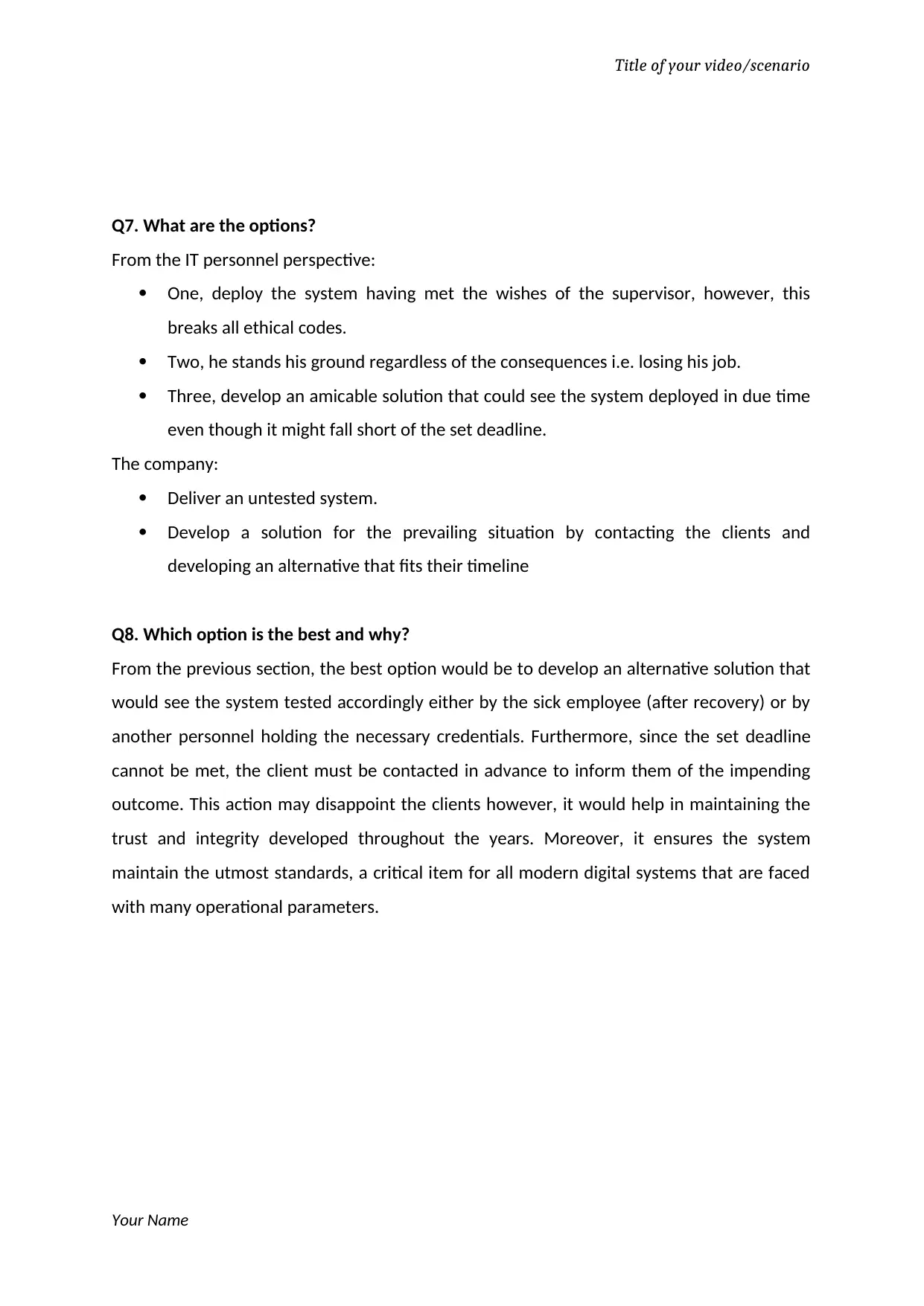
Title of your video/scenario
Q7. What are the options?
From the IT personnel perspective:
One, deploy the system having met the wishes of the supervisor, however, this
breaks all ethical codes.
Two, he stands his ground regardless of the consequences i.e. losing his job.
Three, develop an amicable solution that could see the system deployed in due time
even though it might fall short of the set deadline.
The company:
Deliver an untested system.
Develop a solution for the prevailing situation by contacting the clients and
developing an alternative that fits their timeline
Q8. Which option is the best and why?
From the previous section, the best option would be to develop an alternative solution that
would see the system tested accordingly either by the sick employee (after recovery) or by
another personnel holding the necessary credentials. Furthermore, since the set deadline
cannot be met, the client must be contacted in advance to inform them of the impending
outcome. This action may disappoint the clients however, it would help in maintaining the
trust and integrity developed throughout the years. Moreover, it ensures the system
maintain the utmost standards, a critical item for all modern digital systems that are faced
with many operational parameters.
Your Name
Q7. What are the options?
From the IT personnel perspective:
One, deploy the system having met the wishes of the supervisor, however, this
breaks all ethical codes.
Two, he stands his ground regardless of the consequences i.e. losing his job.
Three, develop an amicable solution that could see the system deployed in due time
even though it might fall short of the set deadline.
The company:
Deliver an untested system.
Develop a solution for the prevailing situation by contacting the clients and
developing an alternative that fits their timeline
Q8. Which option is the best and why?
From the previous section, the best option would be to develop an alternative solution that
would see the system tested accordingly either by the sick employee (after recovery) or by
another personnel holding the necessary credentials. Furthermore, since the set deadline
cannot be met, the client must be contacted in advance to inform them of the impending
outcome. This action may disappoint the clients however, it would help in maintaining the
trust and integrity developed throughout the years. Moreover, it ensures the system
maintain the utmost standards, a critical item for all modern digital systems that are faced
with many operational parameters.
Your Name
Paraphrase This Document
Need a fresh take? Get an instant paraphrase of this document with our AI Paraphraser
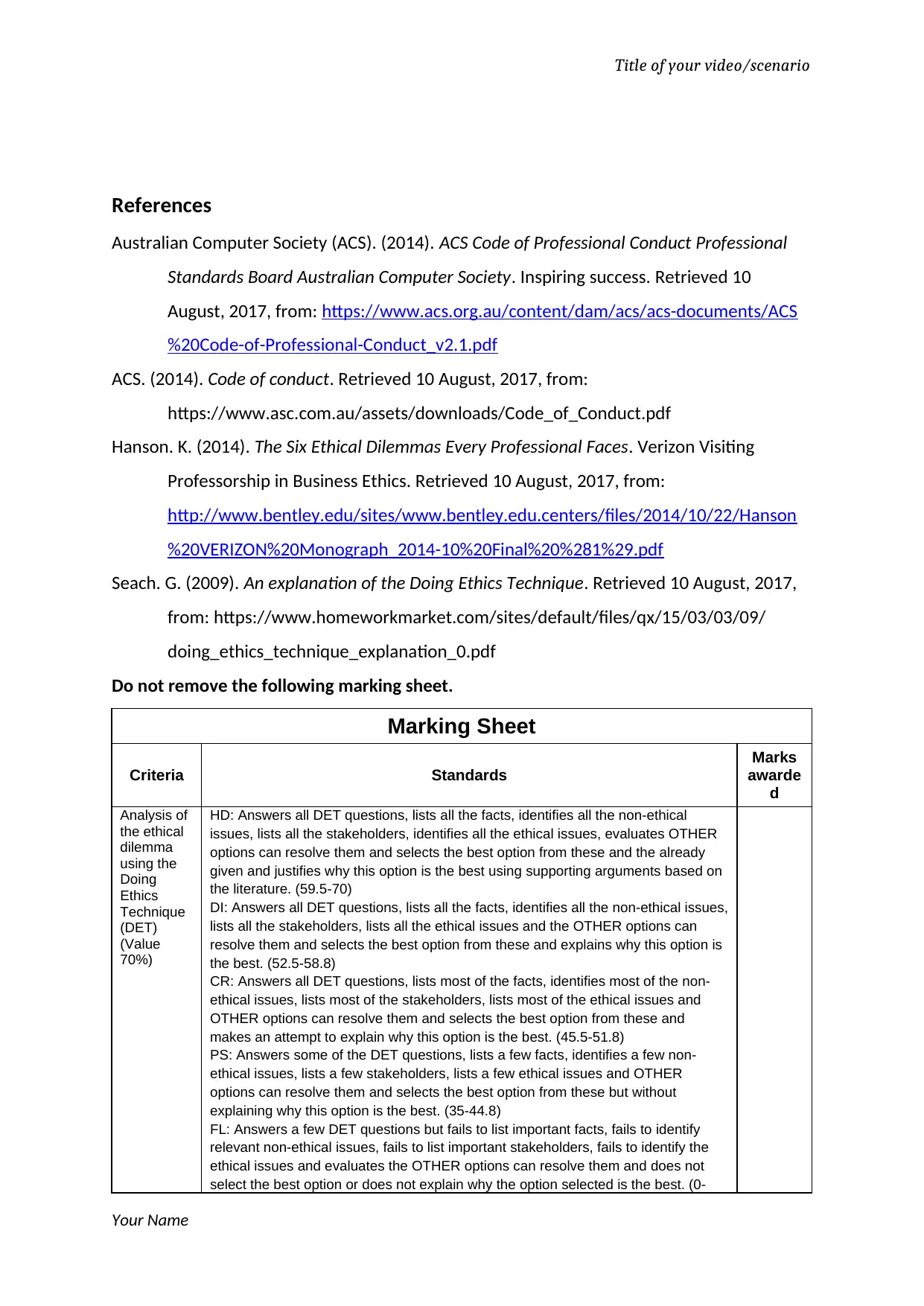
Title of your video/scenario
References
Australian Computer Society (ACS). (2014). ACS Code of Professional Conduct Professional
Standards Board Australian Computer Society. Inspiring success. Retrieved 10
August, 2017, from: https://www.acs.org.au/content/dam/acs/acs-documents/ACS
%20Code-of-Professional-Conduct_v2.1.pdf
ACS. (2014). Code of conduct. Retrieved 10 August, 2017, from:
https://www.asc.com.au/assets/downloads/Code_of_Conduct.pdf
Hanson. K. (2014). The Six Ethical Dilemmas Every Professional Faces. Verizon Visiting
Professorship in Business Ethics. Retrieved 10 August, 2017, from:
http://www.bentley.edu/sites/www.bentley.edu.centers/files/2014/10/22/Hanson
%20VERIZON%20Monograph_2014-10%20Final%20%281%29.pdf
Seach. G. (2009). An explanation of the Doing Ethics Technique. Retrieved 10 August, 2017,
from: https://www.homeworkmarket.com/sites/default/files/qx/15/03/03/09/
doing_ethics_technique_explanation_0.pdf
Do not remove the following marking sheet.
Marking Sheet
Criteria Standards
Marks
awarde
d
Analysis of
the ethical
dilemma
using the
Doing
Ethics
Technique
(DET)
(Value
70%)
HD: Answers all DET questions, lists all the facts, identifies all the non-ethical
issues, lists all the stakeholders, identifies all the ethical issues, evaluates OTHER
options can resolve them and selects the best option from these and the already
given and justifies why this option is the best using supporting arguments based on
the literature. (59.5-70)
DI: Answers all DET questions, lists all the facts, identifies all the non-ethical issues,
lists all the stakeholders, lists all the ethical issues and the OTHER options can
resolve them and selects the best option from these and explains why this option is
the best. (52.5-58.8)
CR: Answers all DET questions, lists most of the facts, identifies most of the non-
ethical issues, lists most of the stakeholders, lists most of the ethical issues and
OTHER options can resolve them and selects the best option from these and
makes an attempt to explain why this option is the best. (45.5-51.8)
PS: Answers some of the DET questions, lists a few facts, identifies a few non-
ethical issues, lists a few stakeholders, lists a few ethical issues and OTHER
options can resolve them and selects the best option from these but without
explaining why this option is the best. (35-44.8)
FL: Answers a few DET questions but fails to list important facts, fails to identify
relevant non-ethical issues, fails to list important stakeholders, fails to identify the
ethical issues and evaluates the OTHER options can resolve them and does not
select the best option or does not explain why the option selected is the best. (0-
Your Name
References
Australian Computer Society (ACS). (2014). ACS Code of Professional Conduct Professional
Standards Board Australian Computer Society. Inspiring success. Retrieved 10
August, 2017, from: https://www.acs.org.au/content/dam/acs/acs-documents/ACS
%20Code-of-Professional-Conduct_v2.1.pdf
ACS. (2014). Code of conduct. Retrieved 10 August, 2017, from:
https://www.asc.com.au/assets/downloads/Code_of_Conduct.pdf
Hanson. K. (2014). The Six Ethical Dilemmas Every Professional Faces. Verizon Visiting
Professorship in Business Ethics. Retrieved 10 August, 2017, from:
http://www.bentley.edu/sites/www.bentley.edu.centers/files/2014/10/22/Hanson
%20VERIZON%20Monograph_2014-10%20Final%20%281%29.pdf
Seach. G. (2009). An explanation of the Doing Ethics Technique. Retrieved 10 August, 2017,
from: https://www.homeworkmarket.com/sites/default/files/qx/15/03/03/09/
doing_ethics_technique_explanation_0.pdf
Do not remove the following marking sheet.
Marking Sheet
Criteria Standards
Marks
awarde
d
Analysis of
the ethical
dilemma
using the
Doing
Ethics
Technique
(DET)
(Value
70%)
HD: Answers all DET questions, lists all the facts, identifies all the non-ethical
issues, lists all the stakeholders, identifies all the ethical issues, evaluates OTHER
options can resolve them and selects the best option from these and the already
given and justifies why this option is the best using supporting arguments based on
the literature. (59.5-70)
DI: Answers all DET questions, lists all the facts, identifies all the non-ethical issues,
lists all the stakeholders, lists all the ethical issues and the OTHER options can
resolve them and selects the best option from these and explains why this option is
the best. (52.5-58.8)
CR: Answers all DET questions, lists most of the facts, identifies most of the non-
ethical issues, lists most of the stakeholders, lists most of the ethical issues and
OTHER options can resolve them and selects the best option from these and
makes an attempt to explain why this option is the best. (45.5-51.8)
PS: Answers some of the DET questions, lists a few facts, identifies a few non-
ethical issues, lists a few stakeholders, lists a few ethical issues and OTHER
options can resolve them and selects the best option from these but without
explaining why this option is the best. (35-44.8)
FL: Answers a few DET questions but fails to list important facts, fails to identify
relevant non-ethical issues, fails to list important stakeholders, fails to identify the
ethical issues and evaluates the OTHER options can resolve them and does not
select the best option or does not explain why the option selected is the best. (0-
Your Name
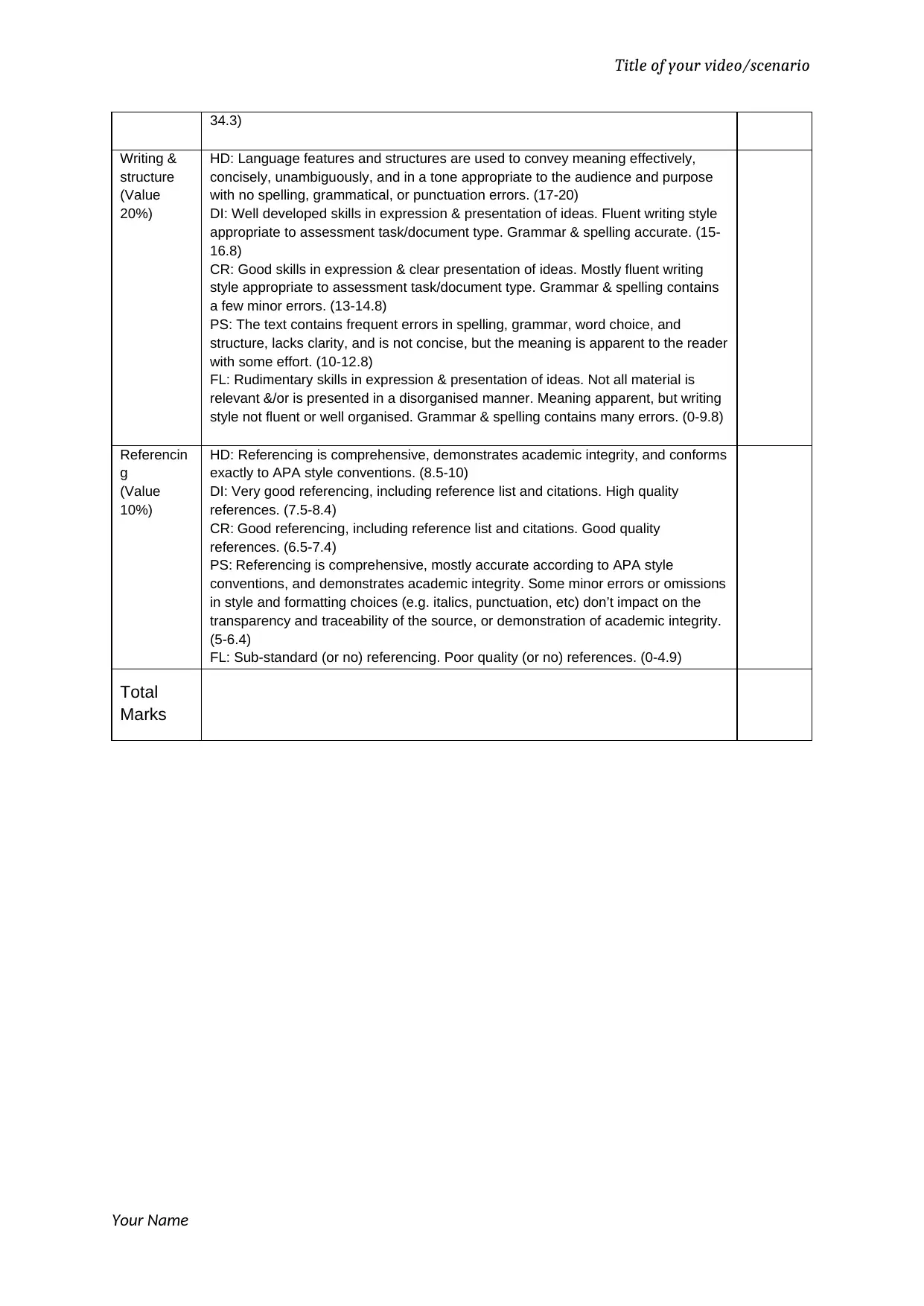
Title of your video/scenario
34.3)
Writing &
structure
(Value
20%)
HD: Language features and structures are used to convey meaning effectively,
concisely, unambiguously, and in a tone appropriate to the audience and purpose
with no spelling, grammatical, or punctuation errors. (17-20)
DI: Well developed skills in expression & presentation of ideas. Fluent writing style
appropriate to assessment task/document type. Grammar & spelling accurate. (15-
16.8)
CR: Good skills in expression & clear presentation of ideas. Mostly fluent writing
style appropriate to assessment task/document type. Grammar & spelling contains
a few minor errors. (13-14.8)
PS: The text contains frequent errors in spelling, grammar, word choice, and
structure, lacks clarity, and is not concise, but the meaning is apparent to the reader
with some effort. (10-12.8)
FL: Rudimentary skills in expression & presentation of ideas. Not all material is
relevant &/or is presented in a disorganised manner. Meaning apparent, but writing
style not fluent or well organised. Grammar & spelling contains many errors. (0-9.8)
Referencin
g
(Value
10%)
HD: Referencing is comprehensive, demonstrates academic integrity, and conforms
exactly to APA style conventions. (8.5-10)
DI: Very good referencing, including reference list and citations. High quality
references. (7.5-8.4)
CR: Good referencing, including reference list and citations. Good quality
references. (6.5-7.4)
PS: Referencing is comprehensive, mostly accurate according to APA style
conventions, and demonstrates academic integrity. Some minor errors or omissions
in style and formatting choices (e.g. italics, punctuation, etc) don’t impact on the
transparency and traceability of the source, or demonstration of academic integrity.
(5-6.4)
FL: Sub-standard (or no) referencing. Poor quality (or no) references. (0-4.9)
Total
Marks
Your Name
34.3)
Writing &
structure
(Value
20%)
HD: Language features and structures are used to convey meaning effectively,
concisely, unambiguously, and in a tone appropriate to the audience and purpose
with no spelling, grammatical, or punctuation errors. (17-20)
DI: Well developed skills in expression & presentation of ideas. Fluent writing style
appropriate to assessment task/document type. Grammar & spelling accurate. (15-
16.8)
CR: Good skills in expression & clear presentation of ideas. Mostly fluent writing
style appropriate to assessment task/document type. Grammar & spelling contains
a few minor errors. (13-14.8)
PS: The text contains frequent errors in spelling, grammar, word choice, and
structure, lacks clarity, and is not concise, but the meaning is apparent to the reader
with some effort. (10-12.8)
FL: Rudimentary skills in expression & presentation of ideas. Not all material is
relevant &/or is presented in a disorganised manner. Meaning apparent, but writing
style not fluent or well organised. Grammar & spelling contains many errors. (0-9.8)
Referencin
g
(Value
10%)
HD: Referencing is comprehensive, demonstrates academic integrity, and conforms
exactly to APA style conventions. (8.5-10)
DI: Very good referencing, including reference list and citations. High quality
references. (7.5-8.4)
CR: Good referencing, including reference list and citations. Good quality
references. (6.5-7.4)
PS: Referencing is comprehensive, mostly accurate according to APA style
conventions, and demonstrates academic integrity. Some minor errors or omissions
in style and formatting choices (e.g. italics, punctuation, etc) don’t impact on the
transparency and traceability of the source, or demonstration of academic integrity.
(5-6.4)
FL: Sub-standard (or no) referencing. Poor quality (or no) references. (0-4.9)
Total
Marks
Your Name
⊘ This is a preview!⊘
Do you want full access?
Subscribe today to unlock all pages.

Trusted by 1+ million students worldwide
1 out of 6
Your All-in-One AI-Powered Toolkit for Academic Success.
+13062052269
info@desklib.com
Available 24*7 on WhatsApp / Email
![[object Object]](/_next/static/media/star-bottom.7253800d.svg)
Unlock your academic potential
Copyright © 2020–2025 A2Z Services. All Rights Reserved. Developed and managed by ZUCOL.
